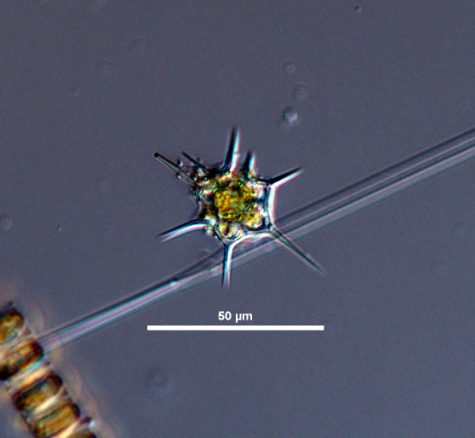
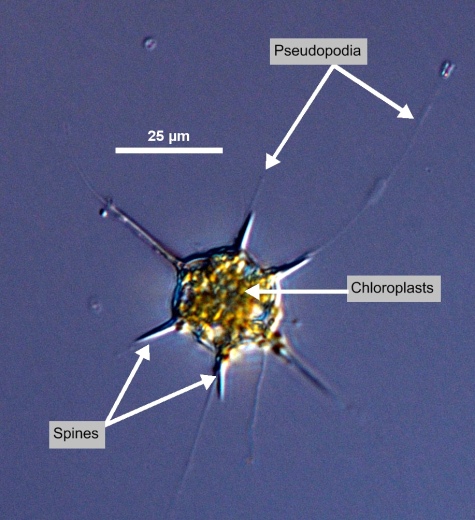
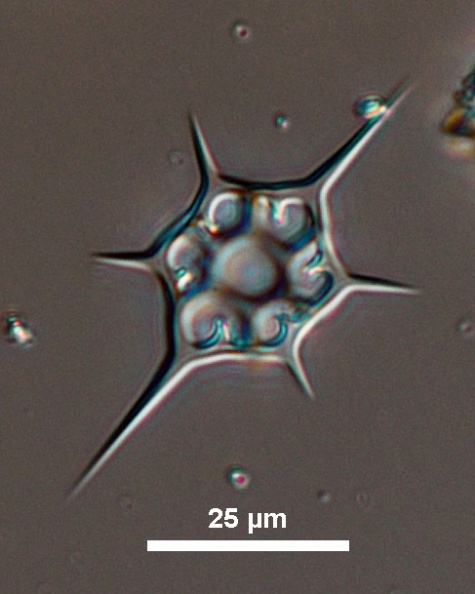

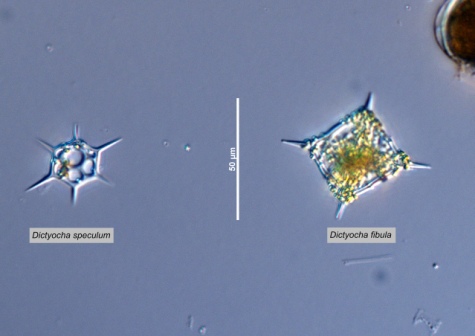
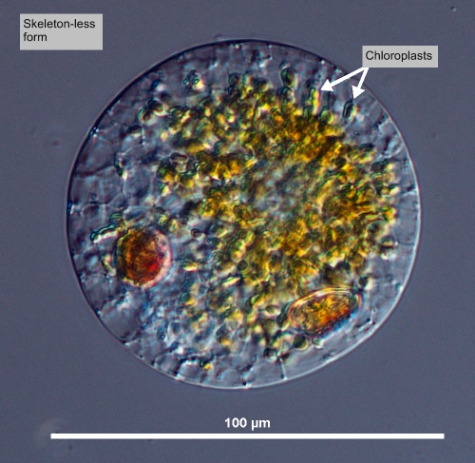
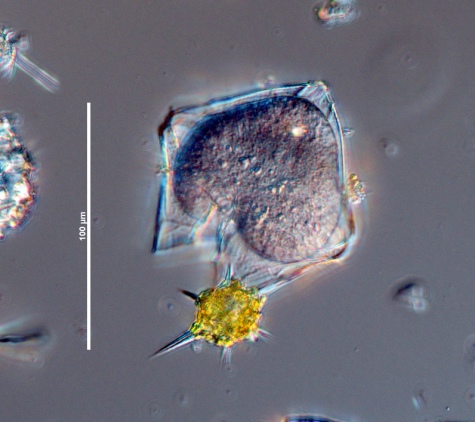
|
Synonym(s)
Cannopilus calyptra Haeckel 1887 Close
Heterotypic
A difference in type. In naming species, a heterotypic synonym is one that comes into being when a taxon becomes part of a different taxon. Compare to homotypic.
(heterotypic)(Horner 2002, Guiry and Guiry 2011)
Classification
(Guiry and Guiry 2011)
Lifestyle
Isogamy
The simplest type of sexual reproduction between gametes that are similar in size and shape. Instead of being classified as male and female cells, organisms of different mating types (i.e., different size and shape of gamete) can fuse to form a zygote (Botany Dictionary 2002).
isogamy; asexual reproduction by CloseAplanospore
A thin-walled spore that relies on water currents for passive transport. It is produced by some phytoplankton (including Scenedesmus and Geminella species [phylum Chlorophyta]) as a means of asexual reproduction. Upon germination, it develops a new cell wall distinct from the parent cell. The production of aplanospores may be a hereditary feature or may be an adaptation to withstand unfavourable environmental conditions (Transeau 1916).
aplanospores and CloseStatospore
An internally formed spore in its resting stage. A thick-walled, resistant spore formed within the frustules of various centric diatoms.
statospores (Guiry 2011). Skeletal, CloseNaked
(athecate, unarmoured dinoflagellates) Without a theca. Referring to "cells without a cell wall" (Horner 2002). The opposite of thecate or armoured.
naked, CloseMultinucleate
Describing an organism containing multiple nuclei. This occurs after a cell division in which the cytoplasm was not divided to form separate daughter cells.
multinucleate, and CloseAmoeboid
(shape) Exhibiting a jelly-like changeable form.
amoeboid stages have been recorded (Horner 2002).Description
Discoid
Disc-shaped.
discoid (Horner 2002). The CloseNucleus
(plural: nuclei) In eukaryotic cells, a membrane-bound organelle that contains the cell's genetic information; the nucleus controls the activities of the cell by controlling gene expression.
nucleus is located in the centre of the cell (Kraberg et al. 2010).Pseudopodium/pseudopodia
A semi-permanent extension of the cytoplasm used for locomotion and feeding by some flagellate protozoans.
Pseudopodia extend from the cell surface (Horner 2002). Flagellum is as long as the cell or slightly shorter (Kraberg et al. 2010).Measurements
Length (multinucleate stage): up to 500 μm
(Moestrup and Thomsen 1990, Haigh 2010, Kraberg et al. 2010)
Similar species
Harmful effects
Anoxic
Describing a condition where there is no available oxygen for primary production. Oxygen may be present in complexed forms that are not available for phytoplankton. A related term is hypoxia, where oxygen is present at very low concentrations.
anoxia, as no toxic effects were found for the naked stage (Henriksen et al. 1991).Habitat
Distribution
Cosmopolitan in cold and temperate waters (Throndsen 1997).
In Northern European seas, it can be found throughout the year, though mainly during late winter and spring (Kraberg et al. 2010). In Danish waters, the skeletal stage is most abundant in the autumn and the naked stage is most abundant in the spring (Moestrup and Thomsen 1990).
Skeletal form is mainly found during spring around Vancouver Island (Haigh 2010).
Growth conditions
Oligotrophic
Describing an aquatic ecosystem with low nutrient and organic matter accumulation and high dissolved oxygen content.
oligotrophic conditions (low CloseNutrients
Various chemical substances that an organism needs for metabolism (i.e., to live and grow). These are usually taken up from the environment. Some examples include nitrate, phosphate, silica (for diatoms), iron, copper, etc. Some nutrients, like copper, are required for growth, but can also be toxic at high levels.
nutrients, high oxygen) than D. fibula due to higher relative abundances in the summer (Rigual-Hernandez et al. 2010).Environmental Ranges
Temperature range (°C): -1.938 - 12.224
Nitrate (μmol L-1): 0.543 - 31.807
Salinity (PSU): 25.730 - 34.979
Oxygen (mL L-1): 6.371 - 8.728
Phosphate (μmol L-1): 0.048 - 2.190
Close
Silicic acid
A general term to describe chemical compounds containing silicon, oxygen and hydrogen with a general formula of [SiOx(OH)4-2x]n. Diatoms polymerize silicic acid into biogenic silica to form their frustules (Azam and Chisholm 1976).
Silicate (μmol L-1): 2.292 - 66.097(OBIS 2011, cited in EOL 2011)
Bloom characteristics
References
Encyclopedia of Life. (EOL). 2011. Dictyocha speculum Ehrenberg. http://www.eol.org/pages/899617. Accessed 26 Jun 2011.
Guiry, M. D. 2011. Dictyocha speculum Ehrenberg, 1837. World Register of Marine Species. http://www.marinespecies.org/aphia.php?p=taxdetails&id=157260. Accessed 26 Jun 2011.
Guiry, M. D. and Guiry, G. M. 2011. Dictyocha speculum Ehrenberg. http://www.algaebase.org/search/species/detail/?species_id=54513. Accessed 26 Jun 2011.
Haigh, N. 2010. Harmful Plankton Handbook. Nanaimo, BC, Canada. 52.
Henriksen, P., Knipschildt, F., Moestrup, Ø. and Thomsen, H. A. 1993. Autecology, life history and toxicology of the silicoflagellate Dictyocha speculum (Silicoflagellata, Dictyochophyceae). Phycologia. 32(1): 29-39.
Horner, R. A. 2002. A Taxonomic Guide To Some Common Phytoplankton. Biopress Limited, Dorset Press, Dorchester, UK. 200.
Jochem, F. and Babenerd, B. 1989. Naked Dictyocha speculum - a new type of phytoplankton bloom in the Western Baltic. Marine Biology. 103(3): 373-379.
Kraberg, A., Baumann, M. and Durselen, C. D. 2010. Coastal Phytoplankton: Photo Guide for Northern European Seas. Verlag Dr. Friedrich Pfeil, Munchen, Germany. 204.
Moestrup, Ø. and Thomsen, H. A. 1990. Dictyocha speculum (Silicoflagellata, Dictyocho-phyceae), studies on armoured and unarmoured stages. K. Danske Vidensk. Selsk. Biol. Skr. 37: 1-56.
Ocean Biogeographic Information System (OBIS). 2011. Dictyocha speculum. http://www.iobis.org/mapper/?taxon_id=434073. Accessed 26 Jun 2011.
Rigual-Hernandez, A. S., Barcena, M. A., Sierro, F. J., Flores, J. A., Hernandez-Almeida, I., Sanchez-Vidal, A., Palangues, A. and Heussner, S. 2010. Seasonal to interannual variability and geographic distribution of the silicoflagellate fluxes in the Western Mediterranean. Marine Micropaleontology. 77(1-2): 46-57.
Throndsen, J. 1997. The planktonic marine flagellates. In: Tomas, C. R. (ed.) Identifying marine Phytoplankton. Academic Press, Inc., San Diego. 591-730.
